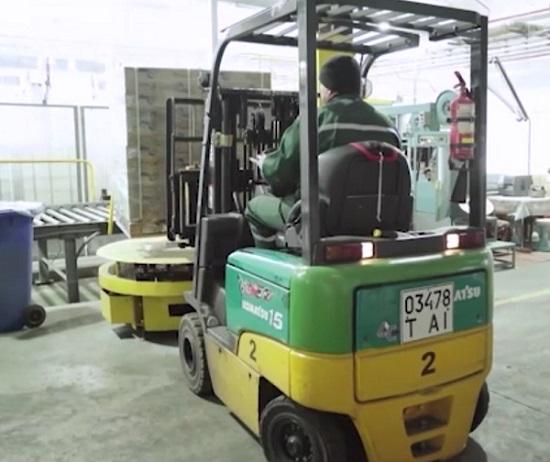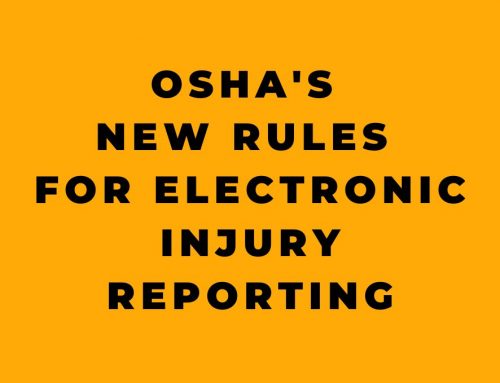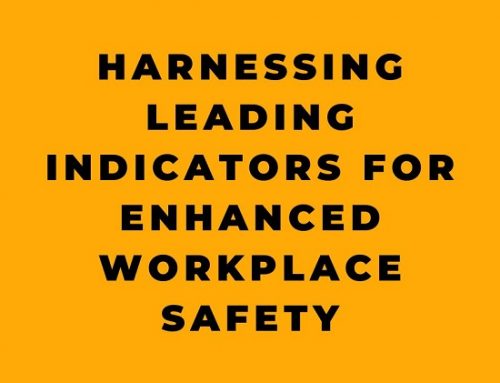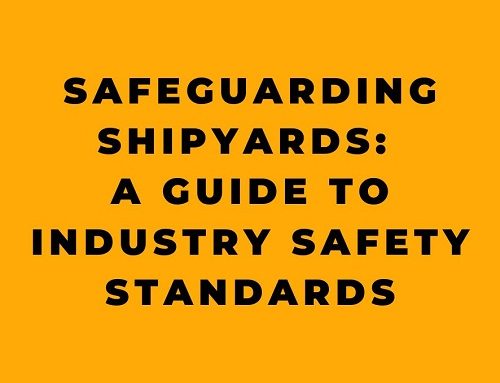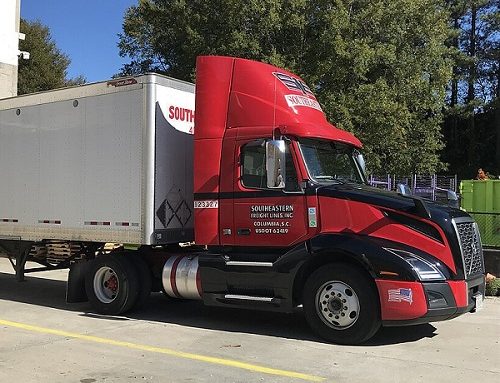Working in a warehouse or manufacturing facility usually means having to move heavy materials and products from one place to another. Often this is done using a piece of powered equipment that the Occupational Safety and Health Administration (OSHA) refers to as a “powered industrial truck.” Of all the different types of these handy machines, by far the most common is the “industrial counterbalance lift truck”—what most of us call a forklift.
While forklifts allow workers to move loads quickly and efficiently, they can also be very dangerous if not used properly. Every year, over 100 people are killed and many thousands more are severely injured in forklift-related accidents. Both pedestrians and forklift operators are at risk. In addition to the terrible human toll, these accidents also cause extensive damage to materials, facilities and the forklifts themselves.
Fortunately, you can avoid becoming a statistic. When you understand how counterbalance forklifts work and how to operate them safely, you and your forklift can become a productive team. This article is derived from our comprehensive online training course, and will teach you everything you need to know to handle these machines properly so you can get the job done without injuries or incidents.
What Makes Counterbalance Forklifts Unique
Contrary to popular belief, running a forklift is not the same as driving a car. Forklifts have different controls, are heavier than cars, steer with their rear wheels, and are inherently unstable because of their design. These unique attributes mean they must be operated differently than an automobile.
The most noticeable difference is that forklifts have front wheels that are mounted on a pivoting axle so they can be turned independently. The rear wheels are fixed in alignment with the forklift and are used for steering. To execute a turn, the operator first applies the brakes to stop forward motion. The front wheels are then pointed in the new direction using the steering wheel. When the brakes are released, the fixed rear wheels cause the forklift to move in the direction the front wheels are pointed. This takes some getting used to.
Forklifts also weigh a lot more than cars. A typical 4,000 lb capacity truck can weigh over 9,000 lbs due to its heavy counterweight. And because they are designed to fit into tight spaces between racks and shelves, forklifts have a very compact wheelbase relative to their weight. This combination of massive weight and a short wheelbase makes forklifts inherently less stable than passenger vehicles.
How Forklifts Maintain Stability
Counterbalance forklifts get their name from the large counterweight built into the rear of the truck. This provides balance for heavyweight loads on the front forks. Because the counterweight is located behind the centerpoint of the forklift and the load is in front, the vehicle acts like a seesaw with the fulcrum somewhere in the middle.
To understand how this works, imagine a line connecting the front steer wheels to the pivot point of the rear axle. This forms what is called the “stability triangle.” As long as the combined center of gravity of the forklift and its load stays within this triangle, the truck will remain upright and stable. But if the center of gravity shifts outside the stability triangle, the forklift can easily tip over.
When the forklift is unloaded, its center of gravity is somewhere behind the front wheels due to the counterweight. This places the center of gravity safely within the stability triangle. As a load is added to the forks, it shifts the combined center of gravity forward. With a balanced load, the center of gravity will be at or near the front wheels. Exceeding the capacity rating of the truck moves the center of gravity entirely in front of the front wheels, taking it outside the stability triangle. This causes the forklift to tip forward.
To maintain stability, the operator must know the capacity of the forklift and make sure loads don’t exceed that rating. The load capacity plate on the forklift will also indicate the maximum load center—the distance forward from the forks that the center of gravity of the load can be located. Exceeding this specified load center can also cause the truck to tip over. We’ll talk more about capacity, load centers, and safe loading techniques later in the course.
Safe Driving Practices
Driving a counterbalance forklift safely starts before you even turn the key. Ask yourself if you are physically and mentally ready and able to operate this heavy equipment safely. Feeling ill, upset, overly tired or taking medications that cause drowsiness are red flags that should prevent you from getting behind the wheel. You should never operate any vehicle while impaired by drugs or alcohol.
Once seated in the operator’s position, buckle your seatbelt before moving the truck. Look around the forklift carefully to make sure your driving path is clear. Follow normal “rules of the road” by keeping to the right side of aisles and giving pedestrians the right of way. Always look and drive in the direction the forklift is traveling, not sideways. Keep arms and legs inside the operator compartment at all times.
Accelerate, turn and brake smoothly to keep the forklift under control. Uneven movements can cause shifts in the center of gravity that affect stability. Never engage in horseplay or drive recklessly. Maintain a safe speed of 5 mph or less, even without a load. This allows you to stop quickly if needed.
Make sure to slow down even more when cornering. The high center of gravity causes the forklift to lean to the outside of turns, reducing stability. Come to a complete stop, then turn the steering wheel slowly and steadily to maintain control. Never turn at high speeds or with elevated or overloaded forks which raise the center of gravity.
Watch for spills, trash or loose materials that could cause slippery surfaces. Even small objects can cause the forklift to skid. Stay away from the edges of docks and platforms to avoid dropping the wheels off the edge. If a wheel goes over the side, it will likely cause the truck to tip over.
What To Do In A Tipover
Even when following safe procedures, upsets and tipovers can still occur. If this happens, stay with the truck! Do not attempt to jump clear. Brace your feet firmly and hold onto the steering wheel to keep from being thrown out. Lean away from the point of impact to help counterbalance the tipping action.
When leaving an unattended forklift, neutralize potential hazards. Lower the forks flat to the floor, shut off the engine, set the parking brake and remove the keys. If parked on an incline, chock the wheels. Never leave a forklift unattended on a slope or with the forks elevated.
Mast & Fork Position Affects Stability
Remember that the forklift’s center of gravity shifts forward as the mast tilts back and the forks raise. This decreases stability. Always keep the forks just 4-6 inches off the ground when traveling, even without a load. This provides the best stability. Only raise the forks as high as needed to clear obstacles and shelf openings.
Tilting the mast forward also lowers the forks, shifting the combined center of gravity back within the stability triangle. Even with a load, slight forward tilt helps counterbalance the weight and improves stability. Never travel with the mast tilted all the way forward as visibility is severely reduced.
Respect Load Capacity Ratings
The maximum load capacity, shown on the data plate, is the combined weight of the load and attachments. Exceeding this rating risks tipover. Remember that capacity is rated based on a standard 24-inch load center. This refers to the distance from the tips of the forks to the center of gravity of the load.
Many loads are longer than 24 inches and have a larger load center. This increases the risk of tipping forward. Either reposition the load to 24 inches or less, or determine the reduced capacity rating for the longer load center. Consult the capacity plate or operator’s manual for this information.
Secure Loads Properly
Always position the truck squarely in front of the load and drive straight forward until contacting the pallet. Center the load as much as possible. Make sure the load sits firmly against the vertical face of the forks or backrest. Adjust fork width if necessary to give even support across the pallet. Check that loads are stable and pallets are in good condition before lifting. Use extreme caution when handling loose bricks, pipes or other unstable loads.
Engaging & Carrying Loads
Once a load is fully secured on the forks, lift it only high enough to clear the road surface. Never raise or lower a load while moving. Carry the load tilted back just enough to stabilize it, generally around 2-4 degrees. If the load blocks forward view, drive in reverse with the load trailing to provide visibility.
Stacking multiple loads on the forks can affect capacity ratings and center of gravity. Never stack loads unless your forklift is specifically rated for stacked operation. Even for empty pallets, limit stacking to a safe height that will remain secure.
Watch Overhead Clearances
Look up frequently to check for overhead obstructions like lights, pipes, sprinklers and doorways. Avoid hitting them, even with an unloaded mast. Impact damage can cause dangerous leaks or electrical hazards. Maintain at least 10 feet between the mast/forks and any electrical lines or equipment. Contacting them may result in electrocution.
Use extreme caution when inserting or retrieving loads from racking. Adjust the load height to clear the lowest shelf opening. After loading, lower the forks completely before backing out of the rack aisle. Never travel with the mast extended in racking aisles. Watch for pedestrian traffic between racks as well.
Elevating People On Forklifts
Forklifts can be convenient for raising workers up high for tasks like maintenance, but only when done safely. Never allow anyone to stand on or be lifted while riding directly on the forks. Use an approved platform designed for human elevation. Drive very slowly and use extreme care.
For elevating people, use a securely attached work platform that fully engages both fork blades. Never move the forklift with the platform raised. Do not allow ground personnel under the platform either. Remain in the driver’s seat while workers are elevated, even when stopped. Make sure all raised workers wear fall protection harnesses secured to the platform. Never allow riders on the mast, forks or reach mechanism.
Safe Practices In High-Traffic Areas
In busy warehouses, loading docks, intersections and doorways, vision is often limited by structures, vehicles and people on the move. Stay alert for pedestrians, forklifts and other traffic in these high-risk locations. Make wide turns and watch all sides for potential hazards. Sound the horn well before entering blind corners or intersections to alert others you are approaching.
Come to a complete stop and look both ways before proceeding from a stop or joining traffic flows. Do not assume pedestrians see you. Make eye contact to ensure they notice your presence before attempting to pass by or turn in front of them. Give pedestrians plenty of clearance in case they trip or stumble. Never drive toward anyone standing in front of a fixed object like a wall or post which prevents them from getting out of the way.
No Riders On Forklifts
Do not allow unauthorized passengers to ride on your truck. There is only one safe seat—the operator’s position. Absolutely never let anyone ride on the forks or on top of the load. Keep all body parts inside the operator compartment when driving. Never allow anyone to walk under or work from an elevated load platform. Before working around any forklift, make eye contact with the operator to confirm they see you.
Maintain Safe Distances
When following behind other forklifts headed in the same direction, stay at least 3 truck lengths behind to allow space for stopping. Do not pass in intersections or other congested areas. Avoid distractions and keep adequate attention on the direction of travel. Pedestrians in the facility should not assume trucks will yield or stop for them. While pedestrians technically have the right of way, forklift impacts can be deadly even at low speeds. Always stay aware of your surroundings.
Driving On Inclines & Ramps
Slopes and ramps require extra precautions. Grades shift the center of gravity, decreasing stability. Drive loaded trucks forward going up a slope and backwards coming down. This keeps the load uphill preventing it from sliding off the forks. For unloaded forklifts, travel in reverse going up and forward coming down. Keep the heavier rear end elevated as much as possible for traction.
Move slowly in a straight line up or down slopes—never turn across them. The high center of gravity makes tip overs extremely likely when turning on inclines. Also be very careful transitioning from level ground onto a slope or ramp. Stop completely before driving onto inclined surfaces. Carry loads low to the ground and limit operation on ramps or grades to light loads only. Attempting to turn around on a slope risks a dangerous sideways rollover.
Working Around Trucks, Trailers & Railcars
Loading or unloading trucks, trailers and railcars presents additional concerns. Chock wheels and set brakes before operating inside vehicles to prevent dangerous motion. Ensure the vehicle flooring has sufficient strength to support the forklift and rated load to avoid crashes through weak decking. Use extreme care when handling loose loads like pipes that could penetrate thin flooring.
Install steel dock plates before crossing gaps between docks and vehicles. Check that plates are in good condition and can support combined forklift and load weights. Secure plates in place and align properly with surfaces to allow smooth transitions. Keep travel speed very slow and steady across dock plates. Rushing or careless driving over plates can cause upsets and serious accidents. Always use spotters when loads restrict your vision.
Inspecting A Forklift Before Operation
While often rushed or overlooked, performing thorough pre-operational inspections helps prevent accidents and downtime. Give the forklift a quick visual check before starting each shift or after another operator was using it. Look for leaking fluids, missing parts, low tires or other obvious problems.
Review the operator’s manual if any items are unclear. Pay particular attention to fuel/battery levels, tire pressures and leaks in hydraulic systems. Examine mast chains, rollers and stops for wear and lubrication needs. Make sure forks are not bent, cracked or misaligned. Confirm that all lights, alarms and warning systems function properly. Never operate any forklift that appears damaged or defective. Report issues immediately for repair.
Safe Forklift Refueling & Battery Recharging
All fueling activities require strict safety protocols because of fire and explosion risks. Gasoline, diesel and LP gas are flammable, while battery charging generates explosive hydrogen gas. Only recharge or refuel in designated areas away from ignition sources. Shut off engines beforehand and extinguish all cigarettes and flames. Never allow sparks or open flames nearby.
Propane forklifts require extra care to avoid leaks after shutting off. Close the tank’s service valve while the engine is still on to use up residual fuel in the lines, allowing it to stall out safely. Always wear insulated gloves when swapping propane tanks to prevent frostbite. Check for leaks in fittings and hoses using soap solution.
Recharging electric forklifts also deserves vigilance. Avoid sparks by keeping metal objects away from the battery. The charging process heats batteries, potentially releasing more hydrogen gas. Leave battery covers open to ventilate. Use protective equipment like gloves, aprons and face shields when checking battery fluid levels.
Proper Maintenance Promotes Safety
Well-maintained forklifts operate more safely and productively. Consult the manufacturer’s maintenance guide for all required inspections and service intervals. Typical items to check include tire pressures, fluid levels, belts, filters, and brake, steering and hydraulic systems. Lubricate all grease fittings and slide rails. Watch for loose fasteners that could vibrate off and cause damage.
Keep batteries fully charged and terminals clean. Drain water and sediments from fuel tanks regularly. Use only replacement parts meeting original specifications. If you notice any deficiencies or safety issues during operation, report them right away so repairs can be made before using the truck again. With proper care and maintenance, a forklift will provide many years of reliable material handling services.
Operating A Counterbalance Forklift Takes Skill
As we’ve seen, driving a counterbalance forklift is much more complex than just steering around a warehouse. Their unique stability characteristics require mastery of driving skills that are quite different from a car. Loads must be handled according to precise procedures to avoid tipping. Constant attention to your surroundings is mandatory, despite the confined visibility these trucks have.
While learning to run a forklift safely takes practice, you now have the necessary knowledge. Applying safe operating practices, inspecting your truck and respecting its limitations will keep you accident-free. You’re now ready to meet the challenges of material handling and get the job done safely.
Understanding the intricacies of operating a counterbalance forklift is crucial for ensuring workplace safety and efficiency. From the unique steering mechanism and the role of the counterweight to the importance of load management, this course offers comprehensive knowledge on safely driving and maintaining your forklift. However, even with the best training, operators still face daily challenges that require constant vigilance and a deep understanding of the machine they’re piloting. To fully equip you with the tools you need to excel in your role, we invite you to consider our advanced safety features and technology designed specifically for counterbalance forklifts. Our offerings are not just accessories; they’re investments in safety and productivity.
🚨 Imagine a world where every lift of a forklift doesn’t risk a life. A world where every industrial worker arrives home safely to their family, every single day. Sounds like a distant utopia? It’s closer than you think, and it starts with transforming how we approach forklift safety training. 🚨
🌟 Introducing Our “Forklift Safety: Industrial Counterbalance Lift Trucks” Full-Length Interactive Courses 🌟
🔥 Why Choose Full-Length Courses Over Microlearning?
When it comes to the complexities of operating industrial counterbalance lift trucks, a 3-minute snippet just won’t cut it. Our in-depth courses delve into every nuance, offering a comprehensive approach to forklift safety that Microlearning can’t match.
🎯 Topics We Cover
- What truly distinguishes forklifts from other machinery
- The art of driving a forklift without jeopardizing safety
- Mastering the intricacies of the mast and forks
- Protocols for maintaining an accident-free workspace
- Thorough inspection routines that pre-empt failure
- Refueling and recharging protocols that protect both man and machine
💡 What Sets Us Apart
- In-Depth Understanding: We don’t skim over topics; we dig deep.
- Bilingual: Courses available in both English and Spanish.
- Up-to-date Information: The most current safety protocols and best practices, grounded in real-world application.
⚙️ Benefits
- Reduced Accidents: Say goodbye to the grim statistics plaguing the industry.
- Increased Productivity: A safer work environment means fewer disruptions and more efficient operations.
- Ease of Compliance: Our courses make meeting regulatory guidelines a breeze.
💼 For Whom?
Ideal for facility managers, safety officers, and anyone vested in industrial safety.
🎁 Limited Time Offer
Enroll now and get access to our exclusive Compliance Manuals, available in English—absolutely free!
📞 Call us today to secure a safer tomorrow.
Don’t leave safety to chance. Equip your team with the knowledge they need to operate not just efficiently, but safely.
Click on the link below to learn more:


